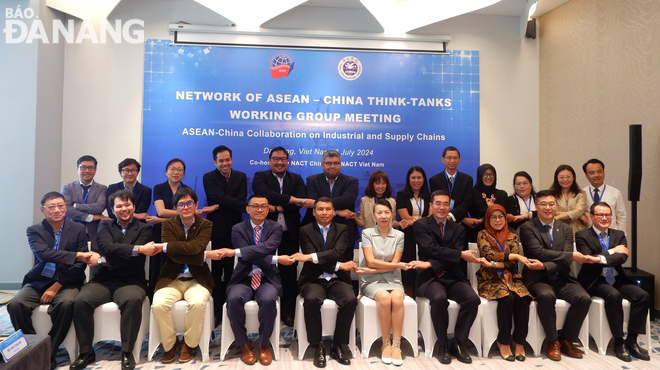New trends shape the future of supply chain shift
The working group meeting of the Network of ASEAN-China Think-Tanks themed “ASEAN - China Collaboration on Industrial and Supply Chains" was held in Da Nang on Saturday.
 |
| Delegates attending the working group meeting. Photo: M.Q |
The event was co-oragnised by the Diplomatic Academy of Viet Nam under Ministry of Foreign Affairs, and the China Foreign Affairs University.
Delivering his opening speech at the event, Dr. Vu Le Thai Hoang, Director of the Institute of Strategic Studies of the Diplomatic Academy of Viet Nam, said the Network of ASEAN-China Think-Tanks (abbreviated as NACT) was established in 2014 to promote exchange and cooperation between ASEAN and China.
Since its inception, NACT has played a key role in facilitating the exchange of ideas, research and policy recommendations on issues of common concern, thereby helping to bridge differences and promote cooperation.
The year 2023 marked the 20th anniversary of the ASEAN-China Strategic Partnership. Looking back on this journey, ASEAN and China have experienced two decades of success in supply chain and trade coordination.
China's trade volume with ASEAN increased nearly 12 times since 2003 and reached an impressive US$ 911.7 billion in 2023, making ASEAN become China’s the largest trading partner since 2020.
China has become ASEAN's largest source of imports, especially industrial goods and components, and has emerged as the third largest source of foreign direct investment (FDI) in ASEAN with a total FDI capital of US$ 18 .65 billion in 2022.
These figures highlighted the deepening economic relationship and the seamless integration of the ASEAN-China supply chain, creating a solid foundation for future cooperation.
Entering the third decade of cooperation, ASEAN and China are at a critical juncture as facing three major challenges: the increasing fragmentation of the global economy; existential threats posed by climate change and environmental degradation; and the transformative influence of emerging technologies such as artificial intelligence.
Despite many challenges, the ASEAN-China partnership still holds many opportunities by leveraging common strengths in production, technology and human capital.
ASEAN and China can foster the development of new industries, promote the adoption of green technology, and create inclusive economic opportunities for the people.
Furthermore, the ASEAN-China partnership can serve as a catalyst for deeper integration and cooperation, contributing to building a more prosperous, stable and harmonious region and world.
 |
| Permanent Vice Chairman of the Da Nang People's Committee Ho Ky Minh speaking at the meeting. Photo: M.Q |
In the abovementioned context, Viet Nam sets clear priorities in economic development, focusing on attracting high-quality, effective and sustainable FDI.
Viet Nam is actively implementing projects involving hi-tech, innovation, research and development as well as ones that create conditions for domestic businesses to participate in the value chain and promote the growth of digital economy, green economy, and circular economy.
Viet Nam also targets to promote Da Nang and many coastal cities to continue upgrading, acting as an important node in the supply chain network between ASEAN and China.
Speaking at the meeting, Permanent Vice Chairman of the Da Nang People's Committee Ho Ky Minh remarked that the central coastal city boasted a favourable geographical position and was one of the gateways facing the sea of the East - West Economic Corridor. The city can become a part of global production and supply chain network due to the advantages of connecting the Pacific and Indian Ocean regions.
In order to maximise the advantage of its strategic geographical location, while enhancing connectivity to make Da Nang an important hub in the supply chain in Southeast Asia and China, the city has built and issued many policies.
In particular, priority has been given to boost the development of a number of fields such as information technology, electronics, and telecommunications industries associated with the digital economy, semiconductor industry, and artificial intelligence applications.
The city has been mobilising all resources to build the Lien Chieu Port to become the gateway port of the logistics service supply chain to ASEAN and Asia-Pacific countries.
Most recently, the National Assembly of Viet Nam has passed a resolution on urban government organisation and piloting a number of specific mechanisms and policies for city development, of which Da Nang is the first locality in Viet Nam to be allowed to establish the free trade zone to pilot policy mechanisms on attracting investment, trade, and logistics.
The Resolution is an important driving force for Da Nang to realise its goals of becoming one of the major socio-economic centres of the country and the Southeast Asia region by 2030; and a large, ecological and smart urban area, a centre for innovation startups and a liveable coastal city at the Asian level by 2050.
Vice Chairman Minh highlighted that the event provided the good opportunity for scholars to discuss, share and propose strategic solutions to facilitate stakeholders to participate more deeply in the supply chain, and promoting goods production and consumption.
He pledged that the municipal government will create the most favourable conditions for foreign investors to invest, do business effectively and live peacefully in the city.
Accordingly, the working group meeting featured many discussion sessions, with a focus on analysing new trends in shifting industrial chains, global supply chains and assessing impacts on the economies of China and ASEAN countries.
The opportunities and challenges facing ASEAN countries and China in the new context were presented, thereby making a number of recommendations to continue promoting cooperation between the two sides.
Reporting by M.QUE - Translating by M.DUNG, V.DUNG